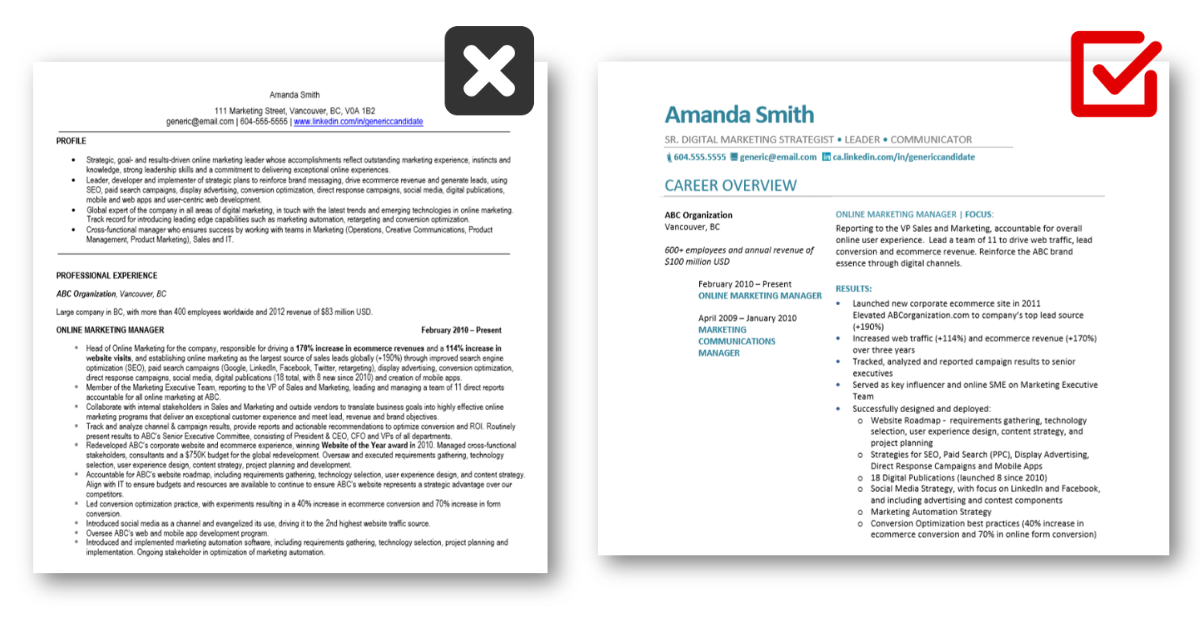For Job Seekers
Applying
5 Steps to a Better Resume
Talk to five hiring managers and you’ll likely get five different versions of what the perfect resume looks like. You’ll hear conflicting advice like…
Resumes should only be one page.
Resumes can be up to five pages.
Never use colour.
Always add a pop of colour.
Add personal flare with creative fonts
Keep your fonts clean—only use Times New Roman
…And on and on!
One size doesn’t fit all for most things in life, and resumes are no exception. This is good! No need to cram your unique career path and experiences into a template that doesn’t show your best side.
The resume has morphed from a bland business document into your personal marketing tool. This is your opportunity to pack a one-two punch of style and substance.
Your resume should be a reflection of who you are as a professional and an individual. It should tell your story, highlight your achievements, and showcase your skills in a way that sets you apart from the crowd.
So, don’t be afraid to break free from the cookie-cutter templates and create a resume that truly represents you. Whether it’s through innovative design, compelling storytelling, or a focus on your unique strengths, make sure your resume stands out and leaves a lasting impression on potential employers. After all, in the competitive world of job hunting, a personalized and captivating resume can be your ticket to success.
Focus on Results
Your resume needs to clearly identify what you did in your current and previous roles. This sounds like a subtle difference from “what you do” but the results, quite literally, are the difference in getting noticed.
DO NOT simply copy your job description.
e.g., “Lead website development for clients, including SEO strategy”
DO share your accomplishments in specific terms.
e.g., “Updated website for an eCommerce client with a strategic SEO plan to capture an expanded target audience segment; unique visitors increased by 37% within 3 months of launch.”
DO NOT assume others will understand your job based on your job title.
Titles don’t explain the scope of your role and your level of decision-making, accountability, or leadership. A Marketing Coordinator can be a junior role in a large organization or the does-it-all marketer handling everything from strategy to execution in a small company of 10 people.
It’s crucial to go beyond the title and provide specific details about your responsibilities, accomplishments, and the impact you’ve had in your role. Use quantifiable metrics to highlight your achievements and demonstrate how you’ve contributed to your organization’s success. This will give potential employers a much clearer understanding of your capabilities and the value you can bring to their team, regardless of the title you’ve held in the past. Remember, it’s not just about what you’re called; it’s about what you’ve achieved and what you’re capable of accomplishing in the future.
DO include a brief overview of the focus of your jobs
Tell your own story by sharing where you fit in your organization’s hierarchy, the size of your team/accounts/budget, etc., and what you’re responsible for delivering on a regular basis.
Describe your role and responsibilities in detail, emphasizing what you’re accountable for delivering on a regular basis. Whether you’re managing a team of ten or overseeing a multi-million-dollar budget, these specifics help prospective employers understand your level of expertise and the challenges you’ve conquered.
By providing this context, you not only showcase your qualifications but also allow potential employers to see how your experience aligns with their needs. Remember, your resume is your narrative, and it should convey not just what you’ve done, but who you are as a professional and what you can bring to the table in your next role.
DON’T assume the reader understands your language.
Relying on industry jargon to tell your story can backfire, even if it’s the most efficient way to pack the most information into the smallest space. Save (most) of the acronyms for texting with your bestie.
Aim for clarity and simplicity. Explain complex concepts or specialized terms when necessary, ensuring that anyone, regardless of their familiarity with your industry, can understand the value you bring.
Remember, your resume serves as an introduction to your qualifications and experiences, and it should be designed to resonate with both human resources professionals and hiring managers who may not be intimately familiar with the intricacies of your specific field. Clear and concise language will always be your best bet in making a favorable impression.
DO use plain language to describe the non-technical aspects of your role.
Assume that your resume may get screened by someone who doesn’t do the same type of work as you and aim for plain language with minimal acronyms. Get a friend in another line of work to give it a quick read – if they don’t understand what you do, rewrite!
This approach ensures that your resume can effectively communicate your qualifications and accomplishments to a wider audience, increasing your chances of making a positive impression on hiring professionals from various backgrounds. Clarity and simplicity in your resume can be a powerful tool in showcasing your abilities and securing the job opportunities you desire.
5 Ways to Improve Your Resume Layout
Once you’ve got your content working hard for you, take a critical look at your resume layout to make sure your amazing job results aren’t buried in bad formatting.
The issue of electronic scanning aside, consider making it easy for a human who may have to flip through 25 resumes to find you and quickly see that you’re a match for the role.
Yes, you may agonize over each word choice in your poetic summary, but your resume is evaluated on how closely it meets specific job criteria. So how can you help to make your key information easy to find?
- White space: Generous margins, spacing around headings, comfortable type size.
- Headings and subheadings: Tell your reader exactly what is in each section and make sure your headings stand out from the body content.
- Bullet points vs. paragraphs: Use the appropriate style for the type of information being shared.
- Consistent format: Choose a style for headings, a place for dates, titles, etc., and stick to it. Too many fonts, type sizes, underlining, and italics combos are brutal to follow.
- Friendly language: Warm and personable language is an easier, and more enjoyable, read than blocks of 14-letter words and endless acronyms.

Put In the Time. Get Noticed.
Crafting a compelling resume isn’t just a formality; it’s a strategic endeavor that can significantly impact your professional journey. It’s your foot in the door to a job interview or phone screening, or even just a click-through to your LinkedIn profile.
Make sure every word on that page serves the purpose of showcasing your qualifications, experiences, and potential contributions to your future employer. It’s your chance to make a memorable first impression, so give it the attention it deserves, and let it shine as your ticket to the next exciting chapter in your career.
Ready to Make a Move?
Smart, Savvy + Associates is a boutique recruitment agency that specializes in helping companies find and hire the marketing, communications and creative professionals they need. From coordinators to C-suite, Smart Savvy is here to simplify the recruitment process and provide best-in-class candidates for their clients in (and around) Vancouver, BC.
Looking for your next opportunity? Visit our job board to apply for one of our open roles or join our ever-growing talent network.


